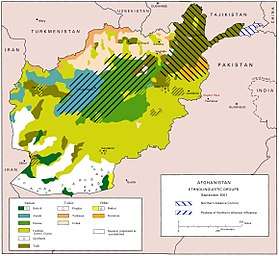Khost Province
Khost (Pashto: خوست, Persian: خوست) is one of the 34 provinces of Afghanistan, located in the eastern part of the country. To the east, Khost Province is bordered by North Waziristan and Kurram in Pakistan. Khost Province used to be part of Paktia Province in the past, and the larger region surrounding Khost is still called Loya Paktia ("Greater Paktia").
Khost خوست | |
|---|---|
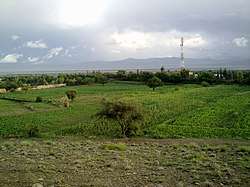 A village in the Nadir Shah Kot District of Khost Province | |
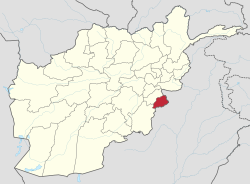 Map of Afghanistan with Khost highlighted | |
| Coordinates (Capital): 33.4°N 69.9°E | |
| Country | |
| Capital | Khost |
| Government | |
| • Governor | Mohammad Sadiq Patman |
| Area | |
| • Total | 4,151.5 km2 (1,602.9 sq mi) |
| Population (2015)[1] | |
| • Total | 574,582 |
| • Density | 140/km2 (360/sq mi) |
| Time zone | UTC+4:30 (Afghanistan Time) |
| Area code(s) | AF-KHO |
| Main languages | Pashto |
The city of Khost serves as the capital of Khost province. The population of the province is around 546,800,[2] which is mostly a tribal society. Khost Airport serves the province for domestic flights to Afghanistan's capital, Kabul.
History
In 1924, Khost Province, then known as Southern Province, was the scene of a rebellion by the Mangal Pashtun Tribe, known as the Khost rebellion. The rebellion was ultimately unsuccessful, and was defeated in 1925 by the Afghan Government. Khost was part of Paktia Province until 1985, when the People's Democratic Party of Afghanistan regime made it a separate province.[3]
Politics and governance
The current governor of the province is Mohammad Sadiq Patman.[4] The city of Khost is the capital of Khost province. All law enforcement activities throughout the province are controlled by the Afghan National Police (ANP). The border of Afghanistan's Khost province with neighboring Pakistan's FATA is monitored and protected by the Afghan Border Police (ABP), which is part of the ANP. The border is called the Durand Line and is known to be one of the most dangerous in the world due to heavy militant activities and illegal smugglings. A provincial police chief is assigned to lead both the ANP and ABP. The police chief represents the Ministry of the Interior in Kabul. The ANP is backed by other Afghan National Security Forces (ANSF).[5]
Healthcare
The percentage of households with clean drinking water increased from 34% in 2005 to 35% in 2011.[6] The percentage of births attended to by a skilled birth attendant increased from 18% in 2005 to 32% in 2011.[6]
Education
The overall literacy rate (6+ years of age) fell from 28% in 2005 to 15% in 2011.[6] The overall net enrolment rate (6–13 years of age) fell from 38% in 2005 to 37% in 2011.[6]
Demographics
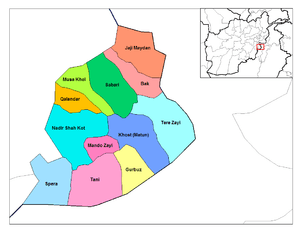
The population of Khost province was estimated to be around 546,800.[2] Other sources put the number at over a million.[7]
The Pashtun people make up 99% of the population, with the remaining 1% being Tajiks and others.[8]
Districts
| District | Capital | Population (2015) | Area[9] | Notes |
|---|---|---|---|---|
| Bak | 22,561 | |||
| Gurbuz | 26,762 | |||
| Zazi Maidan | 23,197 | |||
| Khost Matun | Khost | 140,642 | ||
| Mandozayi | Dadwal | 89,602 | ||
| Musakhel | 41,882 | |||
| Nadir Shah Kot | 32,522 | |||
| Qalandar | 10,440 | |||
| Sabari | Yakubi | 72,364 | ||
| Shamal | 13,920 | Shifted from Paktia Province in 2005 | ||
| Spera | 24,841 | |||
| Tani | Tani | 60,842 | ||
| Tirazayi | Aliser | 45,602 |
Water
Khost Province is traversed by the Kurram River, which rises from the Rokian Defile, passes through the district, and then enters the "country of the Turis or the Kurram Valley".[10]
Gallery
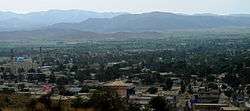 Khost, the capital of Khost province
Khost, the capital of Khost province
 Afghan children
Afghan children A U.S. Marine, assigned to Weapons Company, 3rd Battalion, 3rd Marine Regiment, provides security while in the Khost-Gardez Pass (December 2004)
A U.S. Marine, assigned to Weapons Company, 3rd Battalion, 3rd Marine Regiment, provides security while in the Khost-Gardez Pass (December 2004) U.S. soldiers during a mission (June 2013)
U.S. soldiers during a mission (June 2013) U.S. soldiers during a mission in Tanio area (May 2012)
U.S. soldiers during a mission in Tanio area (May 2012)
See also
- Battle for Hill 3234
- Forward Operating Base Chapman attack
- Forward Operating Base Salerno
References
- Afghanistan at GeoHive Archived 2015-07-21 at the Wayback Machine
- "Settled Population of Khost province by Civil Division, Urban, Rural and Sex-2012-13" (PDF). Islamic Republic of Afghanistan: Central Statistics Organization. Retrieved 2014-01-18.
- Thomas Ruttig (2009). "Loya Paktia's Insurgency: The Haqqani Network as an Autonomous Entity" (PDF). Retrieved 6 August 2020.
- "Ghani appoints new governors for five provinces of Afghanistan". The Khaama Press News Agency. 2020-07-07. Retrieved 2020-07-12.
- Troops Arrive In Khost As Clash With Pakistani Army Continues. TOLOnews. April 15, 2018. Retrieved 2019-03-22.
- Archive, Civil Military Fusion Centre, https://www.cimicweb.org/AfghanistanProvincialMap/Pages/Khost.aspx Archived 2014-05-31 at the Wayback Machine
- On the Road - Khost Province Season 1 (Pashto) on YouTube, Feb 13, 2012, TOLO/USAIDAfghanistan.
- "Khost Province" (PDF). Program for Culture & Conflict Studies. Naval Postgraduate School. Retrieved 2014-01-18.
- Afghanistan Geographic & Thematic Layers
- Imperial gazetteer of India: provincial series, Volume 20. Publisher Supt. of Govt. Print., 1908
- Blowback: The Costs and Consequences of American Empire, by Chalmers Johnson, ISBN 0-8050-6239-4
- "Ghost Wars"
External links
| Wikimedia Commons has media related to Khost Province. |
- Travel on YouTube, November 12, 2015, Shamshad TV.
- On the Road - Khost Province Season 1 (Pashto) on YouTube, Feb 13, 2012, TOLO/USAIDAfghanistan.
- Khost Province by the Naval Postgraduate School
- Khost Province by the Institute for the Study of War

